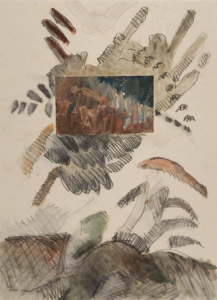Obscure History: Peter Keefer paints WWI personalities in abstract portraits
review of Images of the Great War exhibition at the Missoula Art Museum, May 28–September 19, 2010
by Joe Nickell
printed Friday, May 28th, 2010 in the Missoulian Entertainer,
Missoula, MT
Few of us today recognize the name of Johann Heinrich Graf von Bernstorff. Born in London to German parents in 1862, von Bernstorff became the German ambassador to the United States in 1908, where he remained until the U.S. severed diplomatic ties with Germany in 1917, at the height of World War I. Today, he is known mostly to military history and espionage buffs for his involvement in the infamous “Black Tom explosion” of 1916, in which a cache of American munitions was blown up on a small island in New York Harbor.
Even if you know all this, you might not recognize Peter Keefer’s abstract portrait of von Bernstorff. The oil pastel and photograph collage features a rectangular, television-like box sitting atop three spindly legs against a hazy gray background. Four green ovals hover in front of the box; within the box, two photographs of details from a painting of a bomber cockpit are pasted against a dark background.
Not exactly a literal likeness to the stern-faced man with the handlebar mustache.
The painting–one among numerous abstract portraits of historic figures linked to World War I created by Keefer over the past quarter-century–is part of an exhibition that opens today at the Missoula Art Museum. Titled “Images of the Great War,” the series of paintings explores Keefer’s interpretations of some of the key personalities involved in that watershed war.
Don’t worry if you aren’t well-versed in your World War I history. Neither was Keefer, until long after he began the series.
“I don’t know where the World War I theme came from in the first place, to be honest,” admits Keefer, a 77-year old painter who, together with his wife, Carol Hoffnagle, moved to Missoula in 2003 after spending 20 years as an artist and printmaker in California. “This series really started out with some old failed paintings that I had cut up, and I started pasting those pieces onto paper and doing these abstract paintings around them. It eventually occurred to me that these looked warlike.
“It’s only been since then that I’ve become more involved in the actual thoughts and reading about the war, which now colors how I do stuff.”
That’s one statement that can be taken literally. Over the course of the series, Keefer has taken an increasingly painterly approach to his subjects, replacing stark gestures with rich fields of color and increasingly dense compositions.
One thing has remained constant: the swatches of canvas, most of them swirled with color, that form the starting-point for Keefer’s paintings.
“I like doing collage work in general,” noted Keefer, “because it helps avoid the ‘blank-canvas syndrome,’ not knowing where to start. In this case, it seems to fit the approach I’m taking particularly well.”
Keefer’s collage-based artworks aren’t altogether new to Missoula audiences. For years, his paintings of old barns, with detail photographs of his actual subject matter, incorporated into the compositions, have been seen at area galleries and Missoula Art Museum’s annual Benefit Art Auction.
The series of works currently hanging at the MAM will likely surprise anyone familiar with those highly representational detailed paintings. That’s fine with Keefer.
“Lots of people look down on artists who don’t have one single tube of life that they plow themselves down; but I can’t stand that,” said Keefer. “I’m always trying to do what occurs to me at the time, pushing forward to new approaches.”
Beyond that–and despite the specificity of the titles attached to his paintings–Keefer generally blanches at applying too much description or interpretation to his works. He happily acknowledges that the connections in his work between literal history and abstract imagery aren’t entirely clear; yet he is adamant in preserving the sanctity of the old images–the photographs and scraps of paintings–that he incorporates, unretouched, into his paintings.
He insists that “you can’t describe a visual in words,” yet felt it important to include the text of a historical quote related to World War I with each of the paintings in his exhibit at the MAM.
To him, these seem simply a part of the indescribable reality of the intuitive artistic process.
“If you could tell a painting in words, there’d be no reason to paint it,” said Keefer. “With this series, the piece itself, sometimes in my mind, connects to the person I’ve titled it after; but to me it’s meaningless other than it has to have a title.”
Meaningless? Not entirely. After all, especially in recent years, Keefer has become something of an amateur World War I historian, with dozens of books under his belt (Among his favorites: Frederick Libby’s “Horses Don’t Fly,” David Fromkin’s “Europe’s Last Summer,” and, not surprisingly, Jules Witcover’s “Sabotage at Black Tom”).
To him, the Great War is rife with both symbolic and literal importance.
“It was such an enormous turning point in the life of this planet–it totally changed everything, it was the first mechanized war, and yet one in which armies still tried to fight under the old rules,” said Keefer. “I just think the scope and significance of it was something that’s still hard to comprehend. With this series (of paintings), I feel like I’ve only scratched the surface of what I’d like to address. I’ve got tons of stuff to go.”

